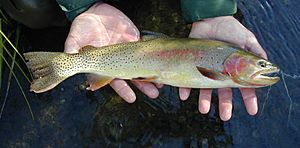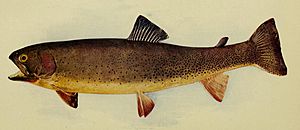Yellowstone cutthroat trout facts for kids
Quick facts for kids Yellowstone cutthroat trout |
|
|---|---|
 |
|
| Scientific classification |
|
| Kingdom: | Animalia |
| Phylum: | Chordata |
| Class: | Actinopterygii |
| Order: | Salmoniformes |
| Family: | Salmonidae |
| Genus: | Oncorhynchus |
| Species: | |
| Subspecies: |
O. c. bouvieri
|
| Trinomial name | |
| Oncorhynchus clarkii bouvieri (Jordan & Gilbert, 1883)
|
|
The Yellowstone cutthroat trout (Oncorhynchus clarkii bouvieri) is a type of cutthroat trout. It is a freshwater fish that belongs to the salmon family. These fish are naturally found in only a few U.S. states.
Their original home was in rivers and streams above Shoshone Falls on the Snake River in Wyoming. They also lived across the Continental Divide in Yellowstone Lake and the Yellowstone River. You can also find them in Idaho, Utah, and Nevada.
The Yellowstone cutthroat trout is a very popular fish for anglers. Many people enjoy Fly fishing for them. This is because adult cutthroat trout mainly eat insects. Other trout, like the brown trout, eat more fish. Cutthroat trout are also less shy than other trout. This means it's often easier for anglers to catch them.
What Does a Yellowstone Cutthroat Trout Look Like?
Yellowstone cutthroat trout have special features. You can tell them apart by their larger black spots. These spots are usually grouped closer to their tail. They can also have gray, gold, or copper colors. Male fish, especially when they are spawning, often have golden brown colors.
All cutthroat trout have a red, pink, or orange mark under their jaw. This mark gives them their name. It also helps tell them apart from rainbow trout.
The size of a Yellowstone cutthroat trout depends on where it lives. They can be from 6 to 26 inches long as adults. Fish in small, high-up streams are usually 6 to 10 inches. The biggest fish live in lakes or in streams that flow into or out of lakes. For example, large ones are found in the Yellowstone River in Hayden Valley in Yellowstone National Park.
Most cutthroat trout in streams and small ponds are 10 to 18 inches long. They usually weigh between 0.5 and 2.0 pounds. In the past, before their homes were damaged and too many were caught, they could grow much larger. Some fish over 30 inches were reported, especially in Heart Lake.
Life Cycle and Reproduction
All Yellowstone cutthroat trout need flowing water to lay their eggs. This means that ponds and lakes must have a stream flowing into or out of them. This allows the fish to reproduce and keep their populations healthy.
Sometimes, fish are put into lakes that don't have streams. This is done to create more places for people to fish.
Threats to Yellowstone Cutthroat Trout
The number of Yellowstone cutthroat trout has gone down over time. This is due to several reasons.
- Overfishing: Too many fish were caught.
- Habitat Loss: Their homes were damaged by mining, grazing, and logging.
- Competition: Other fish like brook, brown, and rainbow trout were brought into their areas. These new fish compete for food and space.
- Interbreeding: Rainbow trout can breed with cutthroat trout. This creates "cutbows," which are a mix of both. This makes the pure Yellowstone cutthroat trout less common.
- Lake Trout: Lake trout were introduced into some lakes. They eat young cutthroat trout.
- Whirling Disease: This is a sickness that affects fish. It has caused problems in streams where cutthroat trout lay their eggs.
Lake trout were put into Shoshone and Lewis lakes a long time ago. But they were never supposed to be in the Yellowstone River area. Their presence there was likely an accident or illegal introduction.
Sometimes, dry weather in the Yellowstone area causes streams to dry up. This prevents young cutthroat trout from moving to Yellowstone Lake. It also makes them easy prey for birds like gulls and pelicans. These problems have greatly reduced the number of cutthroat trout in Yellowstone Lake.
Today, the strongest groups of cutthroat trout are found in the Grand and Black Canyons of the Yellowstone River. They also thrive in the Lamar River and its smaller streams within Yellowstone Park.
In 2004, some groups tried to get the U.S. Fish and Wildlife Service to list the subspecies as endangered species. However, the agency did not approve this. They said that big efforts were already being made to protect these fish.
All Yellowstone cutthroat trout caught inside Yellowstone National Park must be released. Outside the park, fishing rules can change depending on the location.



